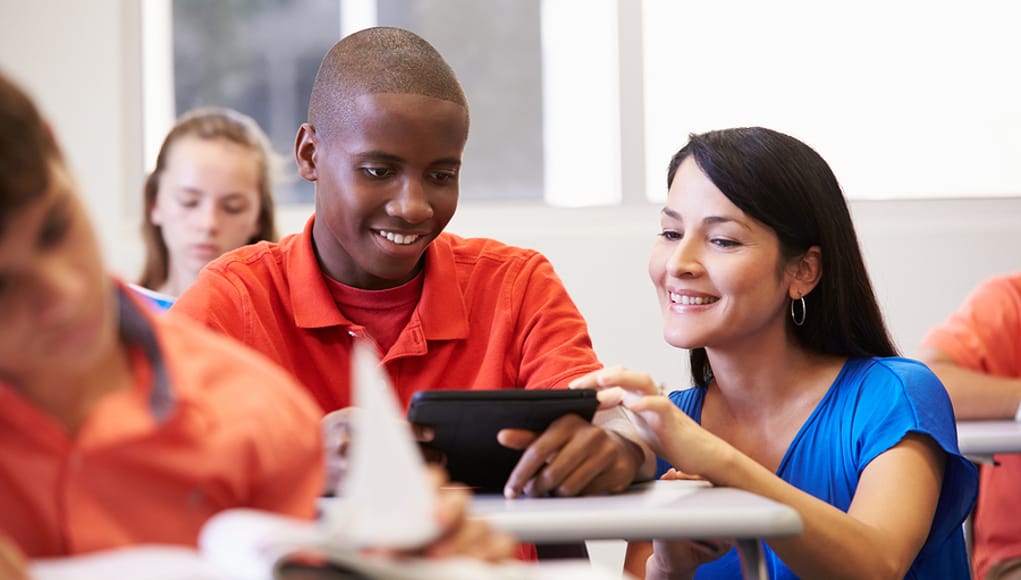Developing Stronger Teacher-Student Connections

By: Tara Brown
“The 18 inches between the head and the heart is a rite of passage…not a right.” I remember a Federal Program Director in a high poverty district telling me that she preached this to her educators all the time. She emphasized the need to earn our way into a child’s head by way of his or her heart. I can say, without a doubt, that statement is by far one of the most powerful I’ve heard in three decades in education. Understanding and committing to this concept is a major key to unleashing the potential of kids of all ages.
Kids don’t care about degrees, letters behind our names, how much we know (or think we know) about a subject, or how many years we’ve been an educator. They care about whether the teacher will like them and believes they are capable. They care if we create an environment in which they are emotionally safe. For decades, research has confirmed that the student-teacher relationship is a foundation of student motivation, engagement, and high academic achievement.
We are hard-wired to connect. Through connections, humans thrive and get their emotional needs met. When a child feels seen, heard, validated and respected, their desire to engage and willingness to take on risk during the learning process increases dramatically.
Four Daily Ways to Strengthen Connections
Research is clear that you cannot get to Bloom’s without going through Maslow. Educators who trust this research understand the importance of providing emotional deposits to kids and creating an environment of emotional safety. Putting kids before content is the first step to making major strides toward building positive connections.
Connecting with kids takes on many forms but all can have a huge impact on a child’s feeling of emotional safety, level of engagement and, ultimately, academic achievement.
- Use Their Names―Dale Carnegie said, “A person’s name is the sweetest sound.” Learning and using kids’ names as quickly as possible sends a clear message that each student is more than a body at a desk. Someone’s name represents him or her as a unique individual, and hearing a teacher use it regularly is a sign of respect and a simple yet powerful connection strategy.
- Make Emotional Deposits―These can take on many forms, from compliments, smiles, and high fives to attending students’ extracurricular activities, writing personal notes, or simply making time for meaningful conversations. Most kids’ emotional accounts are in the red and, if we want academic growth, we have to first fuel emotional growth. These intentional actions speak volumes to a child and emphasize that he or she is seen, heard, and validated.
- Be a Great CEO: Chief Emotional Officer―The mood and climate of the room starts with the teacher. Kids need and want to trust the consistency of the leader. There is already so much inconsistency in many students’ lives and creating stability inside the classroom can make all the difference. Giving them the gift of consistency in moods and energy will help increase emotional safety and the desire to engage.
- Embrace a Strengths-Based Approach―Get to know kids and their strengths and interests. The more teachers know about their students, the more tools they have at their disposal to connect with each one individually and to emphasize students’ strengths. Our job to recognize the strengths our students possess, regardless of the form in which they’re displayed, and translate them into the classroom and their academic journey―to help them harness their qualities for good. Here’s one example of how I did it during my teaching days:
When I was a teacher in Long Beach, California, I had many students who belonged to “tagging crews.” Part of their goal was to spray paint their name in the highest, hardest, riskiest places to reach around the city. And they often risked their lives to do it. It’s not as simple as observing what a student does in the classroom, but in looking closer I could see several strengths on display: courage, commitment, loyalty, determination, problem-solving, teamwork, passion, pride, and creativity.
Once I identified those strengths, I could leverage them, and challenge students regarding as to the quality of work they turned in. I could make the case about how important it was to value their name on the paper as a reflection of who they were as an individual and what they were capable of, just as they took pride in the quality of their graffiti art and/or moniker that they sprayed around the city. By spotlighting how many strengths they used and how they put them into action for their “crew,” I was able to help connect the dots to academics, and how much ability they had to be successful if they used the same strengths.
How You Know Connections Are Working
When teachers have invested time in building great connections and put enough emotional deposits in kids’ accounts, amazing things happen. It’s not unusual for a student to “act out” in one teacher’s class and be a model student in another. There is usually a direct correlation to how connected each teacher is to that particular student.
Connections create an atmosphere where kids want to do their best; they want to get along and they don’t want to disappoint. Teachers that lead with influence see unbelievable growth in kids often viewed as “bad” or “trouble.”
Walk into any classroom with great teacher-student and student-student relationships and you will feel the energy, enthusiasm, and engagement. You will see kids that are focused, attentive, asking questions, and involved in the learning process. There will be few, if any, discipline issues, and the kids will show that they are willing to risk trying―and potentially failing―because there is a class community that is supportive and a teacher that has connected on a heart level.
The Next Step: Helping a Struggling Peer
For some teachers―and some people, in general―connecting doesn’t come naturally. Helping those that struggle with building positive relationships with kids is imperative to ensure that all students can spend their days in a supportive, nurturing learning environment. Once we have developed our own capacity for forming connections with students, supporting our colleagues is the next step toward having an even greater impact.
Depending on one’s relationship with a struggling peer, suggestions and strategies may be best received from an instructional coach or administration. If there is a close connection, having candid conversations about strengths and weaknesses and strategies for growing professionally can be powerful. Teachers that are vulnerable enough to say “I’m not good at building connections with kids” are the very ones that will be open to suggestions and learning.
We can work together with colleagues to collaboratively practice many effective strategies. Simple things like smiling and greeting students at the door to begin the day, celebrating birthdays, having short non-contingent conversations, attending student events, having open body language, and reaching out to parents all convey the message that kids are important and that we feel they are worth the effort. Each of these small acts is one step toward earning our way into their heads. Always remember, #kidsb4content!
Tara Brown, known as “The Connection Coach,” is an award-winning educator, author, and international speaker. Follow Tara on twitter @tarambrown.
For more, see:
- Developing a Sense of Place Means a Deeper Connection to Learning
- Helping Young Children Build 21st-Century Skills
Stay in-the-know with all things edtech and innovations in learning by signing up to receive our weekly newsletter, Smart Update.




0 Comments
Leave a Comment
Your email address will not be published. All fields are required.